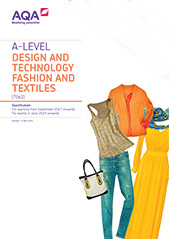3.2 Designing and making principles
Design methods and processes
|
Content |
Potential links to maths and science |
|---|---|
|
Iterative design process. Different approaches to user centred design. That in approaching a design challenge there is not a single process, but that good design always addresses many issues, including:
|
Representation of data used to inform design decisions and evaluation of outcomes. The use of ergonomic and anthropometric data when designing products for humans and specific applications. |
Design theory
|
Content |
Potential links to maths and science |
|---|---|
|
Design influences. How key historical design styles, design movements and influential designers that helped to shape fashion and textile design and manufacture. |
|
|
Design styles and movements. Key design styles and movements and their principles of design, including:
|
|
|
Designers and their work. The work of influential designers and how their work represents the principles of different design movements, including:
|
How technology and cultural changes can impact on the work of designers
Socioeconomic influences
| Content | Potential links to maths and science |
|---|---|
|
Socioeconomic influences have helped to shape product design and manufacture, including:
|
Major developments in technology
| Content | Potential links to maths and science |
|---|---|
|
How major developments in technology are shaping product design and manufacture, including:
|
An awareness of scientific advancements/discoveries and their potential development. |
Product life cycle
| Content | Potential links to maths and science |
|---|---|
|
The stages of the product life cycle, including:
Students should be able illustrate their understanding with examples of how, with reference to specific products, designers have refined and redeveloped products. |
Social, moral and ethical issues
| Content | Potential links to maths and science |
|---|---|
|
The responsibilities of designers and manufacturers, including:
|
Design processes
|
Content |
Potential links to maths and science |
|---|---|
|
The stages of a range of design processes in order to apply personal judgement and relevant criteria in the appraisal of products and systems, including:
|
|
|
Prototype development. Students should be aware of, and able to discuss and demonstrate, the development of a prototype from design proposals. This knowledge should influence the development of design ideas for the NEA so that students may make high quality products the meet the needs of identified users. Students should have knowledge and experience of:
|
The use of mathematics in developing pattern templates |
|
The iterative design process in industrial or commercial contexts. How different design methodologies are used by designers in the corporate world when designing products including collaborative working and the cyclic nature of commercial design and manufacture. |
Critical analysis and evaluation
|
Content |
Potential links to maths and science |
|---|---|
|
Critical analysis and evaluation. Students should be aware of, and able to discuss, their own and commercial products leading to possible improvements/modifications of the original idea. |
|
|
Testing and evaluating products in commercial products. How products are required to undergo rigorous testing, and the testing methods used, before they become commercially available for sale. |
|
|
Use of third party feedback in the testing and evaluation process. How the use of feedback and testing informs the evaluation process, including:
|
Selecting appropriate tools, equipment and processes
|
Content |
Potential links to maths and science |
|---|---|
|
Good and safe working practices, including:
|
Accuracy in design and manufacture
|
Content |
Potential links to maths and science |
|---|---|
|
Measuring and marking out. The importance of accuracy in manufacturing, whatever the scale of production, including:
|
Determining quantities of materials. Calculation of sides and angles of products. Use of datum points and geometry when setting out design drawings. Use of geometry to create templates for designs. |
Responsible design
Environmental issues
| Content | Potential links to maths and science |
|---|---|
|
The importance of environmental issues in design and manufacture, including:
|
Templates for designs. |
Conservation of energy and resources
| Content | Potential links to maths and science |
|---|---|
|
The concept of a circular economy, including:
|
Design for manufacture and project management
|
Content |
Potential links to maths and science |
|---|---|
|
Planning for accuracy and efficiency. The importance of planning for accuracy when making prototypes and making recommendations for small, medium and large scale production. |
Calculations based on economies of scale. The impact of one way designs, nap and pattern on fabric layouts. |
|
Quality assurance. The procedures and policies put in place to reduce waste and ensure manufactured products are produced accurately and within acceptable tolerances, including quality assurance systems, including, Total Quality Management (TQM), and how they are applied to specific examples in fashion, clothing and textiles manufacture, including critical path analysis, scrum or six sigma. |
|
|
Quality control. The monitoring, checking and testing of materials, components, equipment and products throughout production to ensure they conform to acceptable tolerances. Product sampling. Quick response manufacturing teams and quality circles. Automated equipment to check for faults in fabrics. Labelling and quality assurance symbols, eg wool mark, 100% cotton logo, Tencel® logo, Teflon® fabric finish logo. Quality control standards as laid down by BSI and voluntary codes of practice. |
National and international standards in product design
|
Content |
Potential links to maths and science |
|---|---|
|
Relevant national and international standards. Students should be aware of, and able to discuss, the importance of national and international standards in product design, including:
|
